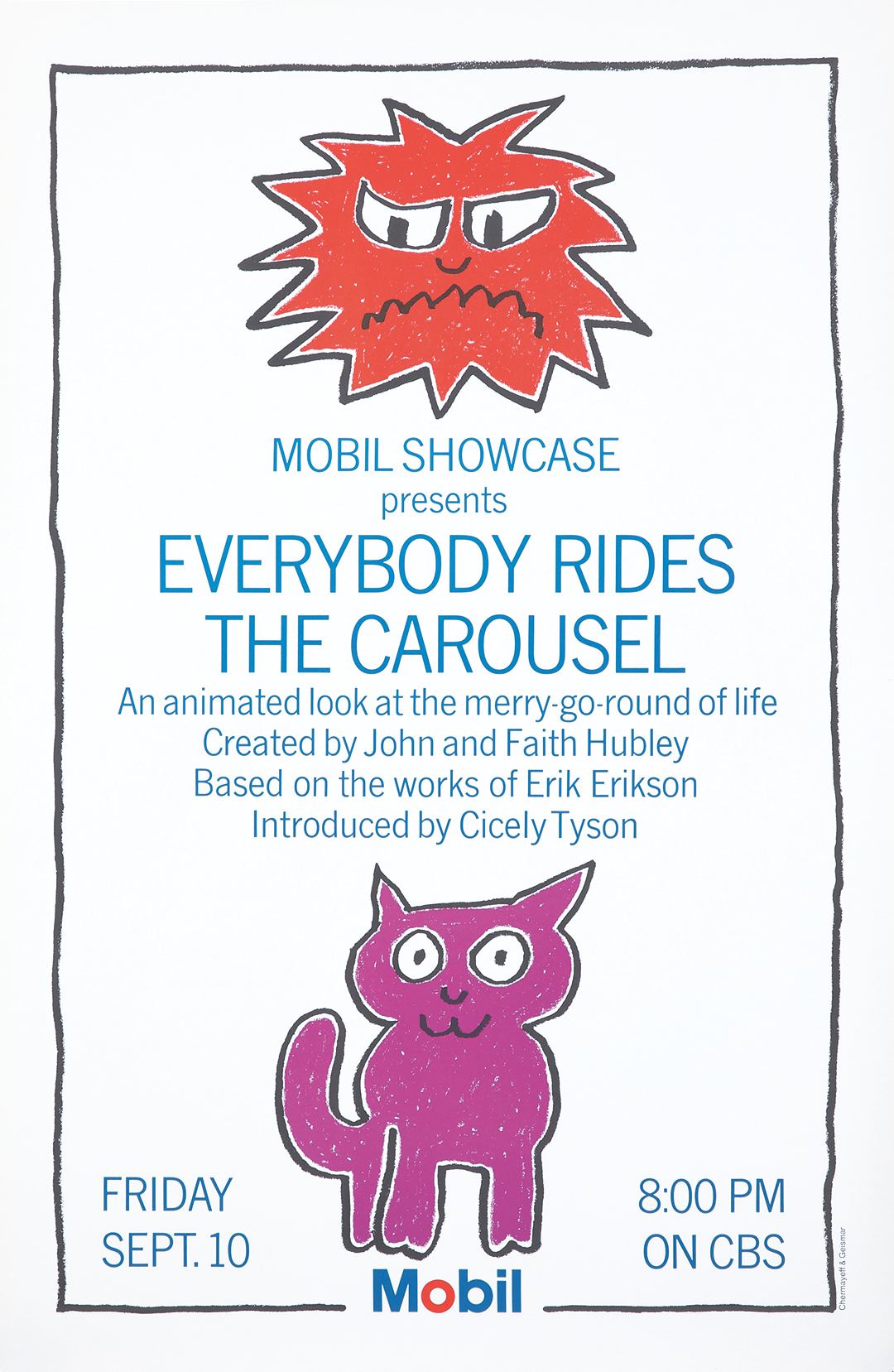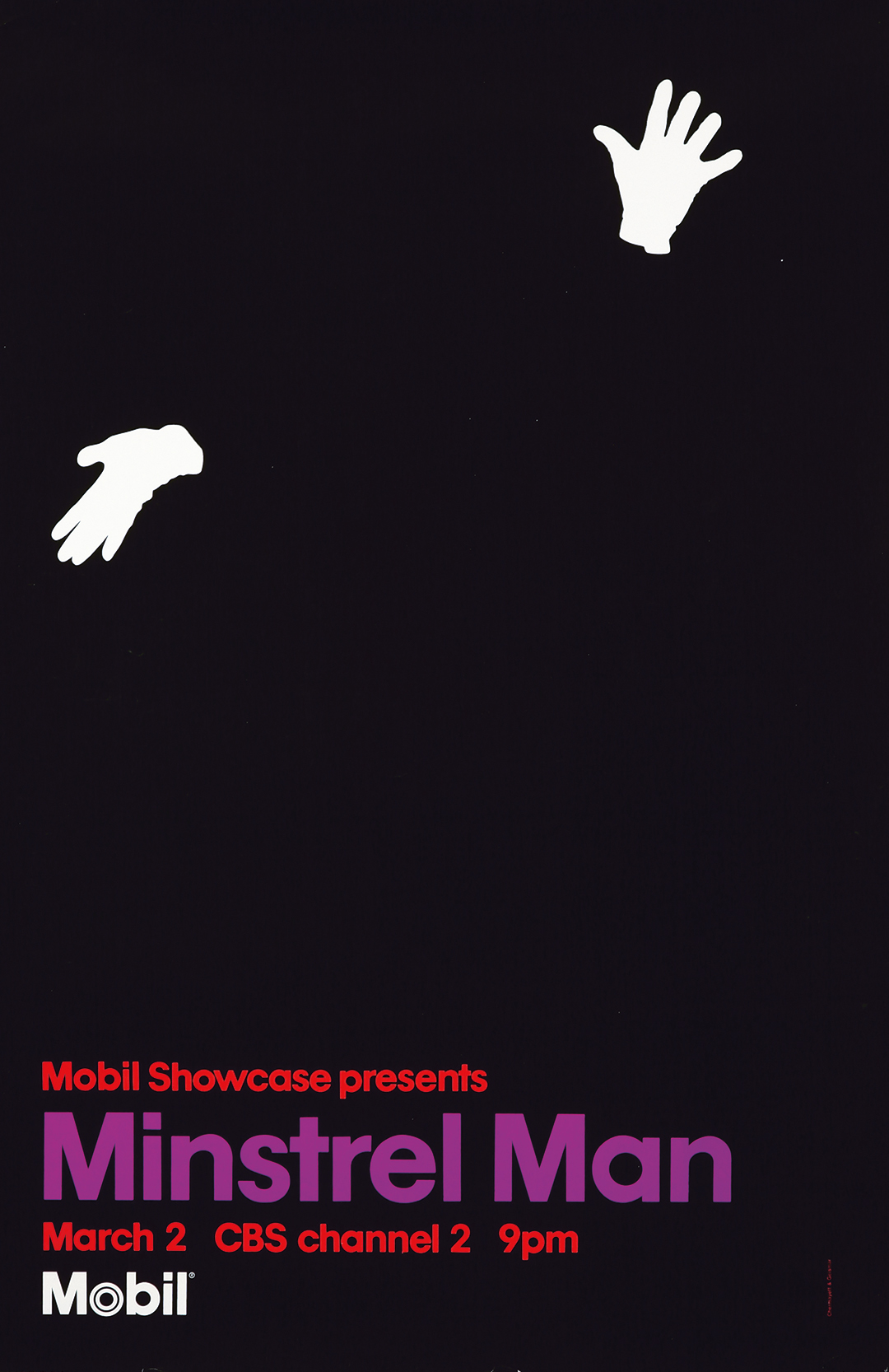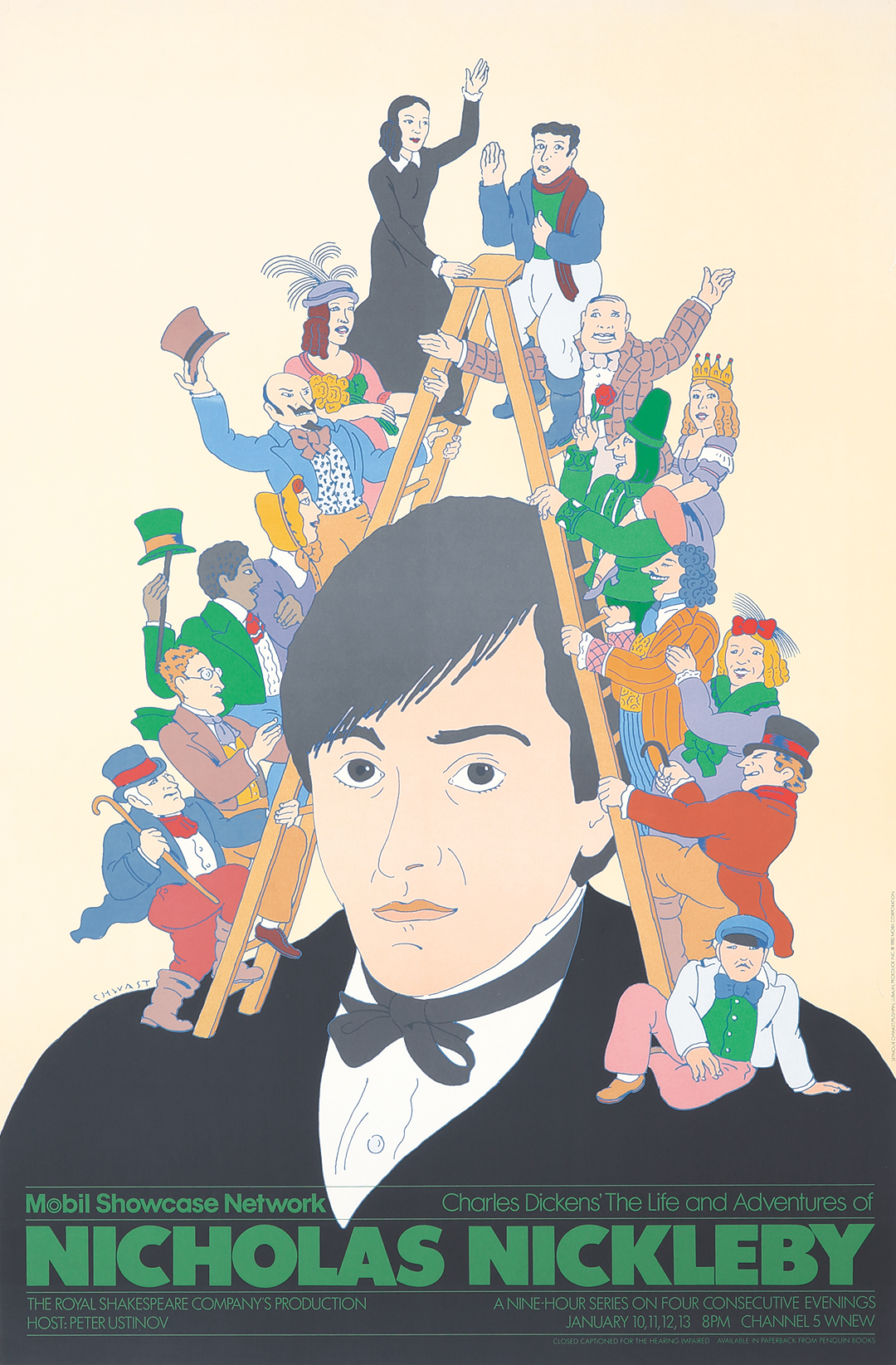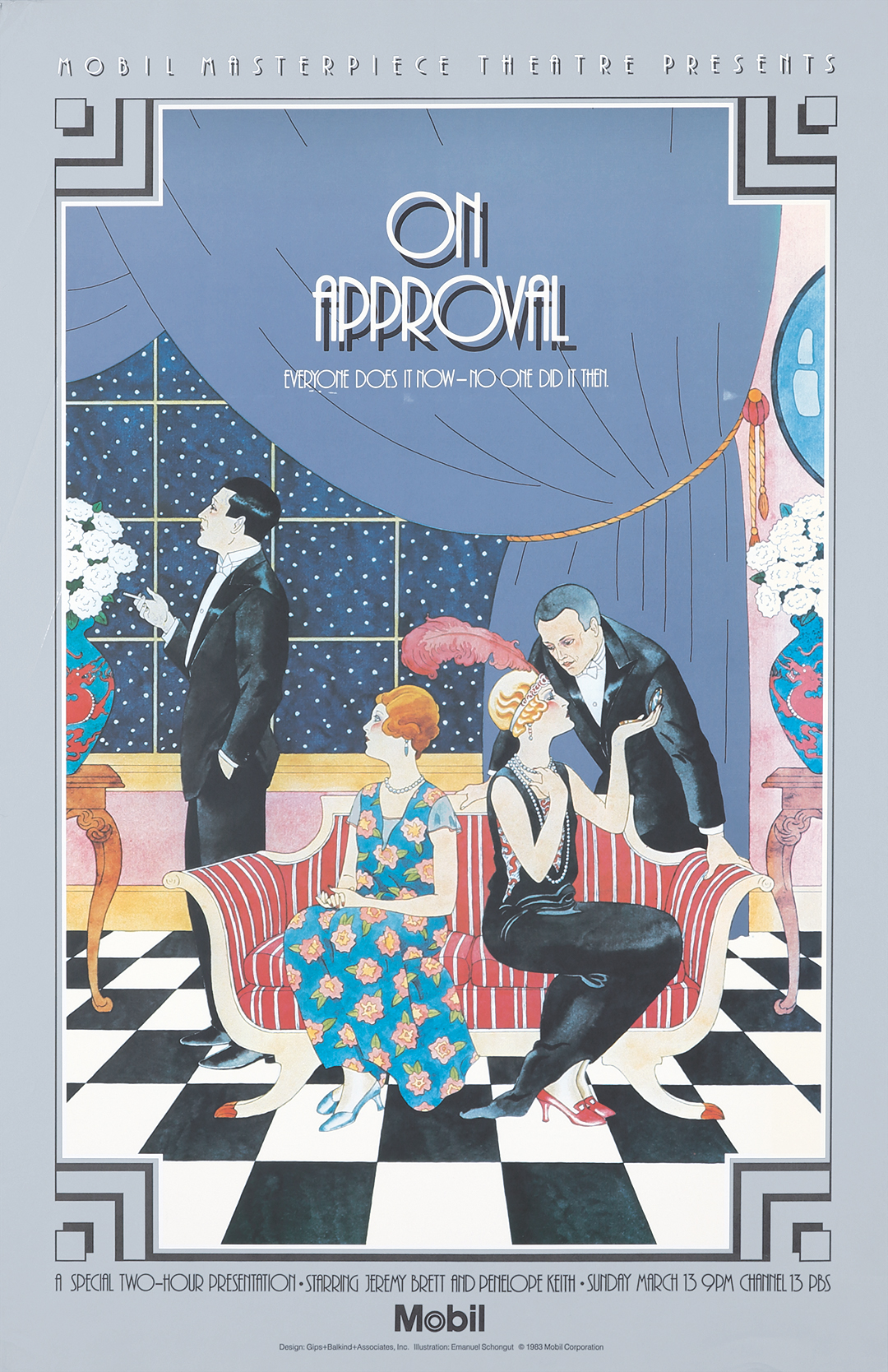Masterpiece Theatre: Classic Posters by Renowned Designers
When Mobil agreed to underwrite PBS programming in 1971, they launched not only an iconic era of TV, but an impressive poster repertoire as well. Mobil enlisted the top American designers of the time: Chermayeff & Geismar, Seymour Chwast, Paul Davis, Edward Gorey, Richard Mantel, Emanuel Schongut, and more—and they churned out consistently innovative and intoxicating designs that became the standard for poster advertising.
“For nearly twenty years, Mobil has been a tireless patron of the art of poster design. …[these posters were] commissioned for the purpose of announcing—and at the same time celebrating—events funded by Mobil in many fields of cultural activity… These posters have in common technical virtuosity of a lofty order and the ability to provoke a wide range of emotions, from merriment to sadness, giving us now the promise-filled faces of children, now the grimly resigned faces of men at war. Glancing through so comprehensive a collection of works of art, we come to appreciate the poster can do simply anything, and do it in almost any medium—pencil or crayon, gouache or oil, photography, or sometimes a mingling of photography, painting, and decoupage. It is a protean form and protean are the goals it pursues.”
— Brendan Gill, Posters made possible by a grant from Mobil
Ivan Chermayeff (1932-2017)
Chermayeff was a legend of graphic design. He mastered the ability to create logos, illustrations, and branding devices that were immediately clear and communicable—though not without a dose of his refreshing whimsy. As co-founder of the New York design firm Chermayeff & Geismar in 1957, he helped build the American commercial landscape as we know it. The firm’s celebrated trademarks include: Chase Bank, Mobil Oil, NBC, National Geographic, the Environmental Protection Agency, PBS, and hundreds more. Chermayeff’s commercial work was often influenced by his own creative work—he constantly drew, made collages from found objects, and accepted any creative work offered to him, including that of designing posters. His posters are great examples of his unorthodox creative vision, his playfulness, and his ability to present information in a manner that is both captivating and concise.
Instead of exploring the period aspects of this literary classic, Chermayeff’s design takes an utterly modern spin and plays up the romance angle. The thigh-high image of a lady’s white stocking superimposed on the photo of a riding boot against a scarlet background manages to suggest a delicious situation in a decorous manner that would surely bring a smile to Jane Austen’s face. This multi-part performance was part of the Drawing Room Intrigue series and originally aired on October 26, 1980.
In addition to memorable series that were being shown for the first time, the 1981 anniversary season also included several outstanding repeats which Masterpiece Theatre dubbed “Festival of Favorites.” This poster makes use of Chermayeff’s original 1972 design for a dramatization based on Honoré de Balzac’s bitter tale of a spinster who deliberately destroys the romance between her young niece and a Polish sculptor, masking her jealous frustration behind a façade of good will. Four hearts—each ruined in a different way—evoke the emotional devastation.
Masterpiece Theatre began its tenth anniversary season (see small logo at right) with a serialized dramatization of “Crime and Punishment.” Chermayeff communicates the anguish of Dostoevsky’s masterwork with the image of a blood-spattered prison cell wall glimpsed through a small barred window with the title scrawled in chalk above. Playing the tortured Raskolnikov was John Hurt, who had appeared as an unforgettably decadent Caligula in the I, Claudius series three years earlier.
Five selected episodes of Upstairs, Downstairs capped Masterpiece Theatre’s tenth-anniversary programming in style. “Television’s most popular series” engaged and enlightened its devoted audience with social and historical commentary on Edwardian England seen through the lens of domestic doings in the townhouse of a wealthy London member of Parliament. The poster here adapts Chermayeff’s original 1974 design for the show’s final season which garnered six Emmy awards. It features an affectionately drawn portrait of lady’s maid Rose as played by big-eyed Jean Marsh, one of the series’ co-creators. The red shape is an allusion to the giant bow at the back of the cap that was a standard part of the uniform at the time.
Chermayeff & Geismar
Ivan Chermayeff and Tom Geismar initially formed their partnership in the late 1950s and went on to revolutionize the field of visual communication and build one of America’s most influential graphic design firms. Together they have created more than 300 corporate identity programs for companies such as Mobil Oil, Xerox, Chase Manhattan Bank, PBS, Univision, and Pam Am. Their work extends from logos to posters and publications to major exhibitions including the United States Pavilions at the World’s Fair in Montreal and Osaka, Japan.
Printed in the mid-1980s, this endearing design advertises PBS’s presentation of Everybody Rides the Carousel, “an animated look at the merry-go-round of life created by John and Faith Hubley, and based on the works of Erik Erikson.” The show was hosted by Cicely Tyson.
This is the ORIGINAL FIRST PRINTING of this poster by the artistic duo Chermayeff and Geismar. Printed in 1977, it was created to advertise the made-for-TV mini-series of Minstrel Man, the story of two black men working in show biz during the early 20th century.
Seymour Chwast (1931- )
Seymour Chwast’s often whimsical designs were a frequent Mobil choice and appear in a wide range of settings: advertising, animation, record covers, packaging, and more than a dozen children’s books. He studied at the Cooper Union School in New York before co-founding Push Pin Studio with Milton Glaser in 1954. Now a principal of the Pushpin Group and a member of the Art Directors Hall of Fame, he has works in the permanent collections of the Museum of Modern Art, the Cooper-Hewitt Museum of the Smithsonian Institution, and the Library of Congress.
Derek Jacobi starred in this imaginative memoir of an ancient Roman Emperor, but evil was the real star of the show. A cup of poisoned wine and a serpent with a fatal bite were two of the tools of betrayal, and Chwast arranged them atop an ingenious portrait of Claudius constructed as a crumbling mosaic.
A nine-hour broadcast on two nights, this was the televising of the marathon English production that brought Dickens to Broadway. The penniless title character is seen here, played by Roger Reese, trying to make sense of life as a host of side characters make their way all over him. Chwast’s humorous line seems especially well-suited to this bunch of tatty theatrical troupers, criminals, cripples, and pure-hearted maidens.
Edward Gorey (1925-2000)
Gorey was a writer and artist who was perhaps best known for his illustrated books, which employed pen-and-ink drawings with a vaguely ominous air in Victorian and Edwardian settings. But he was also a successful costume designer and animator, and his animated introduction for PBS’ Mystery! was particularly beloved. Of course, Gorey applied his macabre aesthetic to numerous poster designs, especially for Masterpiece Theatre.
With a cult following, Gorey’s designs bring to mind macabre Edwardian and Victorian sensibilities, always with a side of wicked humor. In 1980, he was commissioned by PBS to create a variety of posters for its ongoing Mystery! series, as well as its animated introduction. With far less detail than his other images, this chilling design for the Demon Barber of Fleet Street strikes a delightfully ominous chord.
This is an ORIGINAL FIRST PRINTING of this poster by the famous artist Edward Gorey. Printed in the 1980s, it advertises the Mystery! PBS presentation of Father Brown. Hosted by Vincent Price, this is a fabulous piece of television history.
This is is one of the many posters Edward Gorey produced for PBS’s Mystery! series. This particular poster is entitled ‘Shades of Darkness,’ with the subtitle ‘Tales that Terrify.’ The lower middle text reads: “Adapted from stories by Edith Wharton, LP Hartley, Walter de la Mare, May Sinclair, and CHB Kitchin.” This was a seven-part series which began airing on April 12th, hosted by the iconic Vincent Price.
Emanuel Schongut (1936- )
Schongut is a San Francisco based illustrator. In his New York City years, while represented by Push Pin Studios, he worked on projects with Milton Glaser and Walter Bernard at New York Magazine and Seymour Chwast at Push Pin. Working in watercolor, pencil, and pen and ink, his editorial and advertising illustrations have appeared in major publications from The New York Times to Harper’s Bazaar. He has created book jackets and interior illustrations for many publishers in addition to posters for Masterpiece and Mystery Theater.
Printed in 1983, this roaring twenties design promotes the PBS Masterpiece Theatre production of On Approval, a British comedy about two high-strung characters who, by the end of a snowy evening, manage to find love. The tagline reads: “everyone does it now—no one did it then” (referring to marriage).
















